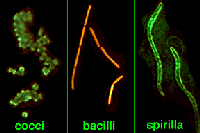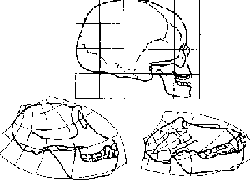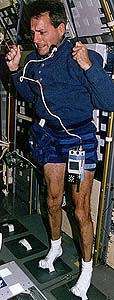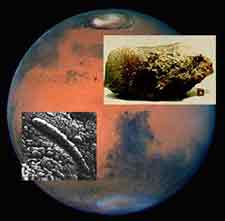|
The
"D'Arcy Machine" and the quest for the 'Book of Life'.
by Leslie
Mullen
In order to
effectively search for life on other planets, we first have to come
to an understanding about what life IS. One way to do this is to
study the forms that life can take, and this is just what NASA is
currently studying with the 'Book of Life' project.
In his 1917
work, "On Growth and Form," D'Arcy Thompson altered mathematical
functions in order to visualise how species changed shape over time.
Scientists are using Thompson's biomathematical studies of life
forms on Earth to postulate about life forms throughout the universe.
There are certain universal conditions that will always affect the
shape of a life form, wherever that life may be.
"Everywhere
Nature works true to scale, and everything has a proper size accordingly,"
wrote Thompson"Cell and tissue, shell and bone, leaf and flower
are so many portions of matter, and it is in obedience to the laws
of physics that their particles have been moved, moulded and conformed."
Gravity, for instance, acts on all particles and affects matter
cohesion, chemical affinity and body volume. Other influences that
are consistent throughout the universe are temperature, pressure,
electrical charge and chemistry.

Professor
D'Arcy Thompson (1860-1948) of the University of St. Andrews
in Scotland.
|
But before we
can conduct a comprehensive search for unknown extraterrestrial
forms of life, there needs to be an extensive classification of
known life forms on Earth. The history of life on Earth provides
us with a good model for how life can evolve in the universe. Fossils,
even microbial fossils, can tell us a great deal about all the different
life forms that have at one time or another shown their face on
our planet.
"Some fossils in the ancient Burgess shale are so alien we can't
determine which end of the creatures are up, and yet these monsters
evolved right here on Earth from the same origins that we did,"
wrote Johan Forsberg, a Swedish psychologist.
By becoming
forensic scientists, researchers can develop an encyclopaedia of
microbial life forms that have developed on Earth. Because so many
life forms need to be catalogued, the scientists are working to
develop a "D'Arcy Machine" to help them create a comprehensive "Book
of Life."
This Book of
Life project has three phases. Phase 1 - compiling a beginning
database of microbial life forms - has already been completed. This
image database is composed of 10,000 examples and distinguishes
the basic microbial shapes such as rods, spheres, filaments, clusters
that look like grapes (cocci), and spirochete (spirals). A computer
neural network has been trained to recognise and classify these
microbial life forms with 90 percent accuracy.

Photo Credit: University of Miami Department
of Biology.
Three types of life forms.
|
Phase 2 of the project will expand the basic database by
using a more powerful neural network. Funds from the NASA Advanced
Concepts Office provided scientists with a Beowulf-class (A Beowulf-class
computer is a cluster of personal computers running LINUX, connected
by its own private Local Area Network) parallel computer, to address
scientific problems associated with large data sets.
Scientists have
named the new parallel computer "Leibniz," after the German mathematician
whose lifelong goal was to organise all human knowledge. This computer
system will expand the image database by acquiring and classifying
new and ambiguous images. To discriminate organic life forms from
inorganic shapes, microbiologists often use the vague criteria,
"Does it look alive to you?" A parallel computer using pattern recognition
can make this task easier and more exact by breaking the starting
image down into identifiable parts.
"Human judgement
is still very much depended upon for identifying microbial life
forms," says Dr. David Noever of NASA's Marshall Space Flight Centre.
"Automated filters would be much like the filters commonly used
to sort out useful e-mail's from useless ones. The user of the neural
network would get a morning menu of microbial candidates for further
detective work."
Although the trained human eye is better at recognising microbial
life forms, using a computer "filter" to check for lifelike patterns
could help cut the immense scale of the Book of Life project down
to a more manageable size.
By Phase
3 of the project, the neural network will be so advanced in
its learning that it will be able to acquire and classify new images
with minimal human supervision. This network would then be equipped
for future search scenarios, including the examination of meteorites
found on Earth and samples retrieved from lunar or interplanetary
space missions. This advanced neural network will be a fast and
efficient classifier of the vast amount of microbial images that
will need to be catalogued.
A Big Problem
This speed and efficiency are extremely important due to the detail
with which the samples must be analysed. Not only are there a lot
of samples to study, but there are multiple dimensions to consider.
D'Arcy Thompson used mostly linear and quadratic maps to compare
different life forms. Linear maps between two shapes require four
coefficient variables, while quadratic maps use 10 variables.
Thompson wrote in "On Growth and Form," "I know that in the study
of material things number, order, and position are the threefold
clue to exact knowledge: and that these three, in the mathematician's
hands, furnish the first outlines for a sketch of the Universe."

Thompson's
sketches of human, chimpanzee and baboon skulls overlaid with
mathematical grids.
|
While Thompson
and other biomathematicians used almost exclusively linear and quadratic
distortions to study how life forms change over time, it is unlikely
that complex life forms throughout the universe will be confined
to these narrow statistical relationships. Accordingly, D'Arcy Thompsons
work is being extended through the use of computers.
When D'Arcy
Thompson introduced the idea of studying organisms by their geometric
shapes, he could only draw figures by hand. The computers of today
can take Thompson's research much further. By repeatedly comparing
and contrasting learnable imagery, a D'Arcy machine would expand
the chapters of the Book of Life Project and give us an interplanetary
version of D'Arcy Thompson's classic "On Growth and Form."
Computers with
artificial intelligence using neural networks provide more opportunities
to answer complex astrobiology imaging questions. The non-linear
evolution of artificial intelligence is customised to handle the
learning of multiple patterns or images. Computers with artificial
intelligence could accommodate various influencing variables (such
as gravity) that change over scales much larger than a linear variance
can include. Changes in the effects of gravity on a body can occur,
for instance, when humans go into outer space. Astronauts often
experience fluid retention, excessive bone loss and muscle wasting
due to the effects of microgravity.

Mission
Specialist Richard Linneham works out how to combat the effects
of microgravity onboard Space Shuttle Columbia.
|
The neural network
at Marshall Space Centre will be able to rapidly process the complex
computations necessary for mathematically analysing the shapes of
life (morphometrics). If someone continuously used a hand calculator
to tabulate just linear connections, at a rate of one calculation
per second it would take forty years to finish a billion calculations.
The computer system speeds up this process dramatically, processing
over a billion connections per second.
Writing the
Interplanetary Book of Life
The powerful capabilities of a D'Arcy classification machine could
also be used to study and catalogue images from the 14 known Martian
meteorites. The total mass to be scanned exceeds 20 kilograms (44
lbs.), so if micron scale images are included in future projects
(1 micron is 1-millionth of a metre, or 1/25,000 of an inch) the
combined image handling capabilities for biogenic classification
will exceed several trillion frames.
Looking for
life forms in Mars rocks for example, means analysing microfossils
- potentially of nanometer-size. So small that 50,000 could fit
across the width of a single strand of human hair.
Based on past
performance, the Antarctic meteorite (ANSMET) field teams are likely
to recover at least 1,000 meteorites over the next three years.
Although it is likely that only a small fraction of these meteorites
will be of interest scientifically, already AMNSET has discovered
28 meteorites that are often sampled for study. Since 1976, 301
individual investigators representing 24 nations have received more
than 10,800 meteorite samples.

The Allan Hills Meteorite (ALH 84001) discovered by ANSMET;
complete with microfossil measuring less than 1/100th the
width of a human hair.
|
To put this
scale of computer acquisition and search in context, compare it
to the challenge of creating the 1996 animated feature "Toy Story."
It took nearly 3 hours for a supercomputer to process each one of
that film's 140,000 frames. The challenge of classifying images
of life forms constitutes a task exceeding the creation of more
than 10,000 high quality computer-animated films.
Life is not
an easy thing to define. Even now, we're finding life forms on Earth
that we never before thought possible. Extremeophiles (bacteria
that live in extreme environments) have been found living in hydrothermal
vents and in high salt environments - areas once thought to be completely
inhospitable to life. In 1997, Stephen Zinder of Cornell University
discovered the existence of bacteria that thrive in the harsh solvents
perchloroethylene and trichloroethylene that are used to clean machine
parts. An acid-loving bacteria, Sulfolobus acidocaldarius, can live
under conditions that would dissolve human skin in seconds.
By using a D'Arcy
machine to begin a study of microbial life on Earth, someday remote
and automated instruments may be able to identify life elsewhere
in the universe - whatever form that life may take.
|
